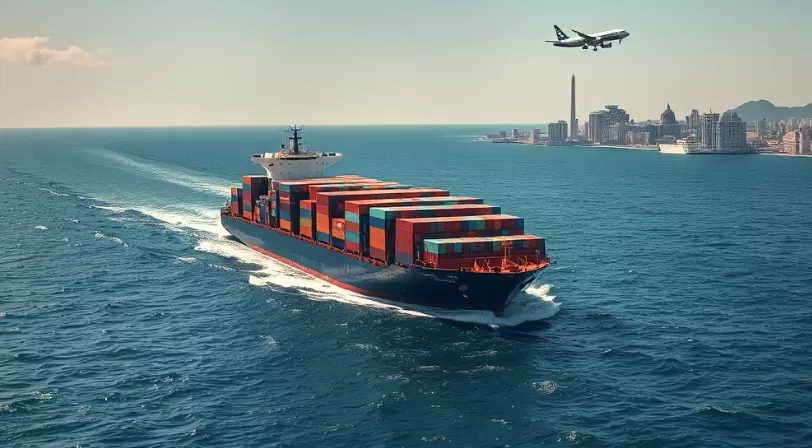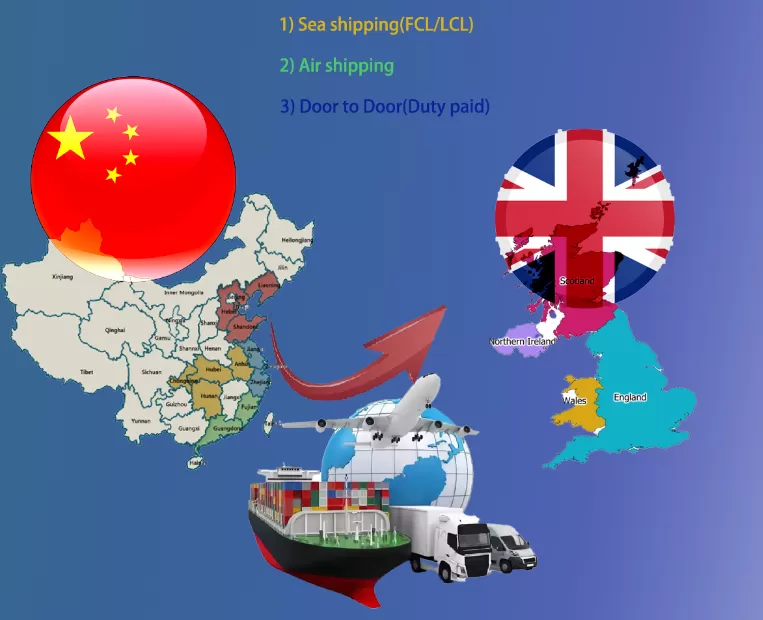An actionable reference guide for traders, Amazon sellers, and logistics managers who need to reliably and cost-effectively ship goods from China to the UK. It covers route selection, realistic transit time and cost ranges, basic customs/VAT/EORI information, FBA and parcel workflows, detailed checklists, risk management, and quick decision-making tools.
Are you ready?
Get real-time quotes for the UK
GET QUOTES
Quick Summary
Typical delivery times (estimated): 25-45 days for full container load (FCL); 30-50 days for less than container load (LCL); 3-8 days for air freight; 3-7 days for express delivery (DHL/UPS). (See routing table and assumptions below.)
Freightos
Cost factors: Freight + fuel and surcharges, local charges at origin, handling and drayage charges at destination, customs/brokerage fees, VAT and duties, and last-mile delivery. Prices vary widely—it's recommended to select two or three quotes.
Required import documents: Valid commercial invoice, packing list, airway bill/bill of lading, correct HS code, and the importer's EORI number. VAT and duties are applicable unless shipped using the Delivered Duty Paid (DDP) method.
GOV.UK
+1
If you're selling on Amazon (FBA): Please allow extra time for FBA preparation, labeling, and warehousing appointments - plan for 14-21 days in addition to shipping time.
China Division
Parcel vs. Freight: For small, high-value items, parcel (express) shipping is fastest; FCL shipping is calculated by volume and offers the lowest unit price. For samples/urgent restocking, use parcel services.
Table of Contents (Skip to Any Section)
Which Shipping Method is Right for Your Situation? (Decision Matrix)
Routes, Ports, and Airports - A Real-World Transit Chart
Cost Structure - How Prices Are Developed with Two Real-World Examples
Documents, Customs, EORI, and VAT - What You Must Submit and Why
Amazon FBA and E-Commerce: A Step-by-Step Preparation Checklist
Parcel (Express Delivery) Strategies for Small Sellers and Consumers
How to Save Money Without Increasing Risk (8 Proven Methods)
Quick Action Checklist (Export/Import/FBA/Express Delivery)
FAQs (Short, Targeted Answers)
Which Shipping Method is Right for Your Shipment?
Use the matrix below to select your default mode; always use quotes for verification.
| Assumption |
Typical volume |
Priorities |
Recommended Mode |
Why |
| Factory → Retail Bulk Replenishment |
≥1 × 40' HC / weekly |
Cost > Speed |
Full container shipping |
Optimal unit price, less processing, predictable planning cycles. |
| Smaller, more frequent replenishments |
2–10 cubic meters per run |
Balancing cost/time |
LCL or FCL consolidation |
Pay by CBM; consolidated services reduce freight but add handling time. |
| Urgent restock / high value |
Small cartons, fast |
Speed > Cost |
Air freight (AWB) |
Faster but costlier; plan for airport-to-warehouse ground time. |
| Samples / small high-value items |
0.1–5 kg |
Speed & traceability |
Express courier (DHL/UPS) |
Door-to-door, customs cleared by courier, convenient for returns. |
| E-commerce FBA replenishment |
Mixed cartons for FBA |
Predictability + compliance |
Sea to UK + domestic prep (or air for urgent) |
Cost effective but add FBA prep time; use FCL for bulk. |
Tip: For most SME sellers, a hybrid plan — sea for base stock, air/express for emergency top-ups — minimizes stock-outs without insane inventory carrying cost.
Routes, ports & airports — realistic transit table (actual routing to use)
Below are commonly used origin/destination pairs and practical transit ranges. These are operational estimates — use them to plan buffers and SLA promises.
Assumptions: door-to-port at origin ~2–5 days; port dwell & loading ~2–5 days; ocean transit subject to routing and transshipment; port congestion and peak season add days. Transit ranges are industry averages.
| Origin (China) |
UK Port / Airport |
Mode |
Typical transit (origin-port to destination-port/airport) |
| Shanghai / Ningbo |
Felixstowe / London Gateway |
Ocean (Direct / Tranship) |
25–40 days. Deepwater hub to SE England. |
| Shenzhen / Yantian / Shekou |
Southampton / Felixstowe |
Ocean (via tranship) |
30–45 days (may be faster for some carriers). |
| Guangzhou / Zhanjiang |
London Gateway / Tilbury |
Ocean |
30–50 days depending on loop & transshipment. |
| Shanghai / Shenzhen |
Heathrow / Gatwick (via cargo) |
Air freight |
3–8 days door-to-door typical (airport transit 1–3 days). |
| Any major Chinese city |
UK (door) |
Express courier |
3–7 days (customs clearance by courier) — fastest small parcel option. |
Operational note: Felixstowe is the UK’s largest container port (SE England) — good for national coverage; Southampton is competitive for roll-on/roll-off and short inventory windows. London Gateway is optimized for large vessels and fast hinterland connectivity.
Cost structure — how prices are built (and two worked examples)
A quotation is not just “freight”. Here are the line items you will see and what they mean:
Core components
Ocean / Air freight charge (carrier tariff) — base commodity.
Bunker & fuel surcharges (variable).
Origin local charges (export documentation, terminal handling at origin).
Destination charges (terminal handling, unloading, port fees).
Drayage / inland transport (port → warehouse).
Customs brokerage & clearance fee.
Import duty & VAT (taxes payable to HMRC; VAT often reclaimable by VAT-registered importers).
Last-mile courier or pallet delivery.
Insurance & other services (warehouse, fumigation, phytosanitary checks).
Worked examples (illustrative estimates — get live quotes):
Example A — 1 × 40’HC FCL (Shanghai → Felixstowe, door in London)
Freight (ocean): illustrative $2,500–$4,500 (market dependent).
Origin & destination local charges + drayage: $600–$1,200
Customs brokerage: $80–$250
VAT & Duty: calculated on CIF landed value (variable)
Total landed cost (not including VAT/duty): roughly $3,200–$5,950 plus taxes.
Example B — Air freight (1000 kg) Shanghai → Heathrow (commercial goods)
Air freight: $4.00–$8.00 / kg typical market range (estimate).
Airport handling / customs / delivery: $300–$700
Total: $4,300–$8,700 (for 1000 kg), plus tax & duty.
Important: these numbers are market-sensitive. Always annotate quotes with the fuel/peak season assumptions and the date. Freightos and similar market indices publish rolling rates — use them as a sanity check.
Freight forwarding
Get real-time quotes for United Kingdom
Get Quotes
Documents, customs, EORI & VAT
Missing or incorrect documentation is the leading cause of delays and fines.
Mandatory documents
Commercial Invoice — seller’s invoice with HS codes, origin, unit values.
Packing List — itemised, with CBM for LCL/containers.
Bill of Lading (ocean) or Air Waybill (AWB) (non-negotiable/negotiable as applicable).
Certificates (where required): Certificate of Origin, Phytosanitary or Health certificates for regulated goods.
Importer’s EORI number — required to make a customs declaration in Great Britain. If the importer does not have an EORI starting with GB, get one before shipping.
VAT & Duty basics
VAT on imports: Goods imported into Great Britain are subject to VAT and possibly customs duty. VAT is due at import unless deferred arrangements or special schemes apply. Ensure you understand the VAT treatment (and whether you can defer VAT) — consult HMRC guidance or your customs broker.
HS codes: classify goods accurately. Misclassification = wrong duty & potential penalties.
Customs declaration: your customs broker or freight forwarder (how to pick the right one for Amazon FBA) will submit the declaration on your behalf (but you remain responsible for accuracy).
Practical checklist to avoid holds
Use consistent descriptions and values across invoice/packing list/manifest.
Always include HS code and country of origin on invoices.
For FBA: comply with Amazon’s label & pallet rules; appointment slots may be required.
Sea-Express — premium ocean service, route examples & when to use it
Definition & value: Sea-Express is a premium ocean product (faster loops, priority loading, fewer transshipments). It’s the middle ground between standard ocean and air.
Route examples
Shenzhen → Felixstowe (Sea-Express): direct or single-tranship loops marketed as express; transit ~15–28 days depending on rotation.
Shanghai → London Gateway (Sea-Express): fewer port calls, expedited port handling — good for retail replenishment.
When to use
Heavy/bulky goods that are time-sensitive but too expensive for air.
Retailers with seasonal peaks who need faster ocean replenishment.
Operational checklist
Confirm Sea-Express loop and guaranteed stowage with carrier.
Consolidate at origin and confirm port cut-off times for express sailings.
Pre-submit import docs to your broker for immediate clearance on arrival.
Advantages
Notable time savings vs standard ocean; lower cost than air for bulky shipments.
Downsides
Premium pricing; capacity may be limited during peak windows.
Sea+Truck — intermodal ocean + road (route examples & notes)
Definition: Sea leg to a major northern European hub or UK port, then scheduled truck leg to final UK hinterland. Useful where direct port calls are limited.
Route examples
Shanghai → Rotterdam (ocean) → Truck → London / Midlands: common when direct UK calls are full or to reach inland warehouses.
Qingdao → Antwerp → Truck → Northern UK (Manchester): northern origin routing via northern EU ports with road uplift.
When to use
Destinations inland or when you want single-contract intermodal delivery.
When port rotation patterns or container availability favor transhipment hubs.
Operational checklist
Clarify where customs clearance (breakdown of the inspection process) will happen (EU transit vs UK clearance) — impacts VAT/duty handling.
Ensure CMR / road transport documents are in place for the truck leg.
Confirm truck slot and buyer’s receiving hours.
Advantages
End-to-end booking with predictable inland timetable.
Downsides
Extra handling increases touch points; ensure transport insurance covers multimodal legs.
Door-to-Door — one contract, route examples & practical use
Definition: Forwarder handles pickup at factory in China and delivers to consignee’s door in UK, covering export, main carriage, import clearance and delivery.
Route examples
Factory (Shenzhen) → forwarder pickup → Sea FCL → Felixstowe → drayage → consignee (London) (DDP or DAP depending on Incoterm).
Factory (Shanghai) → air freight → Heathrow → customs → door delivery (express or air).
When to use
First-time importers, small traders, businesses that prefer a single point of contact.
Operational checklist
Agree Incoterm and who is responsible for VAT/duty payment (DDP vs DAP).
Request a line-itemed invoice from forwarder (avoid opaque lumpsums).
Ensure importer EORI & necessary licences are shared with forwarder.
Advantages
Simplicity and single liability chain.
Downsides
Higher total cost vs port-to-port; potential for hidden markups if not itemized.
Port-to-Port — lowest base freight, route examples & who benefits
Definition: Carrier moves cargo between named origin port and destination port. Shipper/consignee handle origin pickup and destination drayage/clearance.
Route examples
Shenzhen Port → Felixstowe (port-to-port FCL) — best when you have established local trucking & customs brokers.
When to use
Experienced importers who handle local logistics and want the lowest base freight.
Operational checklist
Arrange export haulage to origin port and confirm cut-offs.
Coordinate destination truck pickup and customs broker in advance.
Monitor free time at destination port to avoid demurrage.
Advantages
Lowest base freight cost; control of local leg cost.
Downsides — full operational responsibility and coordination burden.
Amazon FBA & ecommerce: step-by-step
For sellers, logistics is compliance + timing. Here’s a practical process and timing assumptions.
FBA inbound workflow (recommended)
Factory → Consolidation / prep warehouse (China)
Inspect, label, bubble wrap, create cartons per Amazon box content rules.
Book forwarder for chosen mode (air if urgent, sea if bulk).
Export clearance & departure.
Transit (ocean/air).
UK customs clearance — ensure EORI, correct HS and value.
Delivery to Amazon receiving centre — book appointment if required.
Amazon check-in & processing.
Freight forwarding
Get real-time quotes for United Kingdom
Get Quotes
Time planning (practical)
Sea: production → consolidation → ocean transit → UK customs → Amazon inbound = typically 6–10 weeks total depending on prep and buffer. Plan for 8 weeks safe lead time. chinadivision
Air: typically 2–3 weeks including prep and domestic time — use for urgent replenishment.
FBA prep checklist (China consolidation/warehouse)
Products labelled per ASIN requirements.
Carton content sheet attached.
Carton dimensions & weight recorded.
Palletised and shrink-wrapped, pallet height fits Amazon limits.
Pallet ID labels and Amazon shipment labels applied correctly.
Commercial invoice with accurate SKU/ASIN references.
Why sellers still use forwarders like ChinaDivision: specialized FBA services (prep, labelling, FBA compliance) reduce rejects and delays at inbound.
Air and ocean freight rates, delivery times, and availability
Air Freight Pricing, Airports & Lead Times
| Destination |
Cost Per KG (September 2025) |
Transit Time |
Suitability |
| London (LHR) |
$4.20 |
2–5 days |
Time-critical SKUs |
| Manchester (MAN) |
$4.20 |
2–5 days |
Urgent replenishment |
| Birmingham (BHX) |
$4.20 |
2–5 days |
High-value/lightweight goods |
| Liverpool |
~$4.20 |
2–5 days |
Urgent or high-value goods |
| Glasgow |
~$4.20 |
2–5 days |
Urgent or high-value goods |
| Edinburgh |
~$4.20 |
2–5 days |
Urgent or high-value goods |
| Cardiff |
~$4.20 |
2–5 days |
Urgent or high-value goods |
LHR increased to $4.20 (from $3.00), BHX increased to $4.20 (from $4.00), while MAN's price remained flat. Expect stable 2–5 day door-to-door (Amazon FBA door-to-door shipping costs explained) performance.
Sea Freight & Express Shipping Overview
while express and air freight are for time-sensitive cargo.
| Shipping Type |
Cost |
Transit Time |
Best Suited For |
| FCL (Full Container Load) |
$1,400 (20-foot container) / $2,350 (40HQ container) |
20–30 days |
Medium to large shipments, high-volume cargo |
| LCL (Less-than-Container Load) |
No specific data provided |
30–40 days |
Smaller or non-urgent shipments |
| Express Shipping |
Typically ranges from $5–8 per kilogram |
1–3 days |
Small, time-critical goods
|
FCL rates saw a significant reset, with 20-foot containers (20GP) down $500 and 40HQ containers down $900.
Overall Transit Time Comparison:
Express Shipping: 1–3 days
Air Freight: 2–5 days
Sea Freight (FCL): 25–35 days
Sea Freight (LCL): 30–40 days
I hope this translated table is useful for you.
Parcel (courier) playbook — for samples, small sellers & consumers
When to use couriers: samples, small orders, returns, urgent replacements.
Courier advantages
Speed and door-to-door customs clearance included.
Good tracking and claims process.
Predictable SLA for small shipments.
Courier tradeoffs
Higher cost per kg / per item. Not cost-effective for pallets or containers.
How to ship parcels from China to UK (practical tips)
Use the courier’s online booking system and declare HS codes and full values.
Insure items when value justifies it.
Pack to courier specs (avoid soft envelopes for fragile goods).
For commercial parcels, ensure commercial invoice accompanies the shipment (couriers usually require a pro forma/commercial invoice).
How to save money without increasing risk — 8 proven levers
Consolidate shipments — LCL consolidation or FCL optimization reduces unit cost.
Buy predictable capacity — negotiate multi-shipment rates or volume discounts.
Optimize packaging — reduce dimensional weight for air/express and maximize container cubic usage.
Use sea for base stock, air for top-ups — balance inventory & working capital.
Plan around peak season — avoid Chinese New Year and Q4 congestion windows. Book 30–45 days earlier.
Negotiate terminal & drayage bundles — many forwarders can roll charges into a cleaner invoice.
Audit invoices regularly — short erroneous charges and duplicated fees.
Use deferred VAT / postponed accounting (if eligible) — reduces cashflow burden (check HMRC rules & broker).
Quick operational checklists (copy & use)
Export checklist (China side)
Purchase order and packing list ready
Commercial invoice with HS codes & origin
Booking confirmed with carrier & shipping marks on cartons
Required certificates collected (COO, Phytosanitary etc.)
Consolidation/inspection done, photos taken
Import checklist (UK side)
Importer has GB EORI number.
Customs entry prepared with correct HS codes & value
VAT & duties budgeted or deferred if allowed (HMRC guidance).
Carrier/forwarder contact for drayage & appointment booked
Warehouse/recipient ready for delivery
FBA checklist (to give to your China prep warehouse)
ASIN mapping & Amazon labels applied
Carton content list per carton
Pallet build meets Amazon spec
Export documents match commercial invoice & packing list
Freight forwarding
Get real-time quotes for United Kingdom
Get Quotes
FAQ
How long is transit from Shanghai to Felixstowe?
Typical ocean transit ranges 25–40 days (carrier & loop dependent). Allow extra for port congestion.
Do I need an EORI to import to the UK?
Yes. Importers must have an EORI starting with GB to make customs declarations in Great Britain.
What documents are essential for customs clearance?
Commercial invoice, packing list, AWB / Bill of Lading, HS codes, and any certificates specific to regulated goods.
Is DDP better than DDU for small businesses?
DDP transfers the admin burden and VAT/duty payment to the seller — simpler but usually more expensive. DDU (or Delivered at Place) requires importer to clear and pay taxes. Choose based on cashflow and capability.
How is import VAT paid?
Unless a deferred payment arrangement applies, import VAT is payable; VAT-registered businesses can generally claim a refund of import VAT on their VAT return, as required. Please review HMRC guidance.
Should I use air freight for FBA replenishment?
Due to cost, air freight is only used for urgent replenishment; for regular cycles, sea freight is more economical. Allow time for preparation and Amazon check-in.
Can I ship dangerous goods?
Yes, but only via an approved carrier with the correct UN classification, packaging, labeling, and documentation.
What are the reasons for shipments being detained by UK Customs?
Misdeclaration errors, missing certificates, incorrect HS codes, discrepancies in value, or missing EORI. Recent regulatory changes have increased physical inspections of certain goods.
Is LCL cheaper than FCL for small shipments?
For very small shipments, LCL is cheaper; for larger shipments (close to half a container), FCL is generally cheaper per cubic meter.
How are returns to China handled?
Returns require a clear return policy and can be processed via courier or consolidated shipping services. Please plan for customs procedures and potential tariffs.
Exploring Other Major Logistics Routes?
While this guide focuses on the UK, we also provide detailed guides for other major destinations:
United States: Comprehensive US shipping guide with FBA specifics
European Markets: Best freight forwarders for European FBA
Key US Hubs: New York, Los Angeles, Chicago
UK Specific: Shipping to Birmingham for affordable FBA options
Logistics Models: Understand 1PL, 2PL, 3PL, 4PL differences
Compare All Options
Each destination offers unique advantages depending on your cargo type and final distribution needs. Use our detailed guides for Baltimore, Miami, and other major logistics hubs to develop an optimal strategy.

 EN
EN
 FR
FR
 ES
ES
 JA
JA
 PT
PT
 RU
RU
 AR
AR








